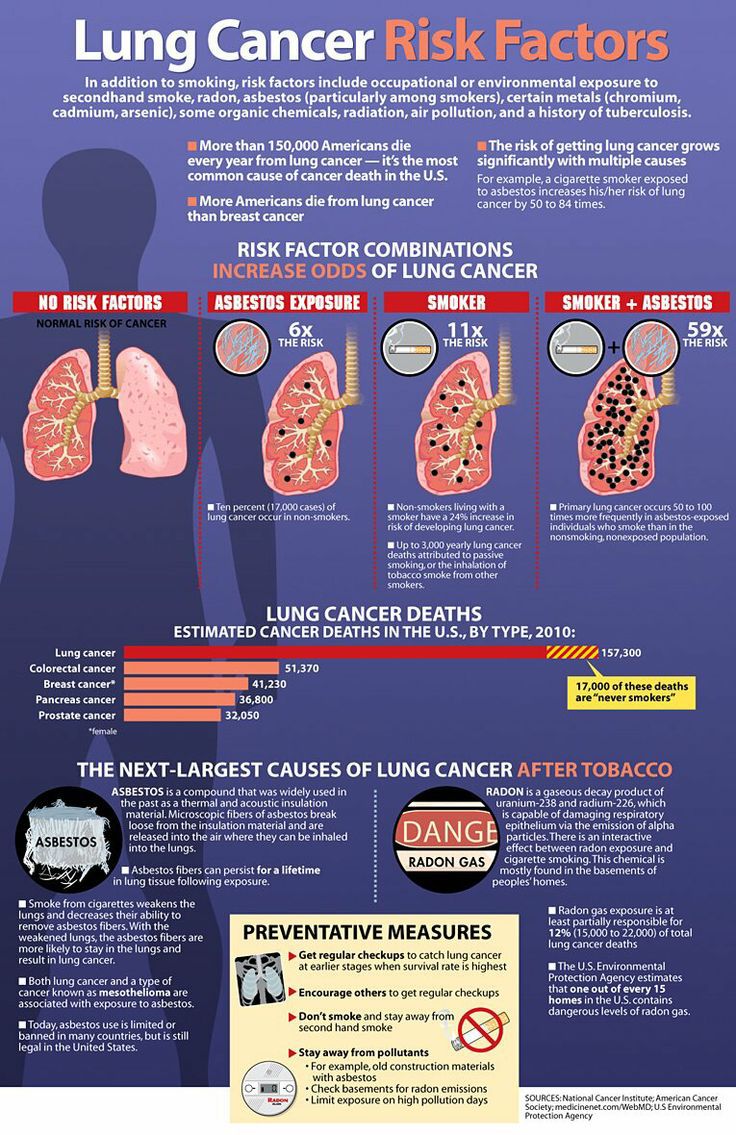Causes of lung cancer
Most cases of lung cancer are caused by smoking, although people who have never smoked can also develop the condition.
Smoking
Smoking cigarettes is the single biggest risk factor for lung cancer. It’s responsible for more than 85% of all cases.
Tobacco smoke contains more than 60 different toxic substances, which can lead to the development of cancer. These substances are known to be carcinogenic (cancer-producing).
If you smoke more than 25 cigarettes a day, you are 25 times more likely to get lung cancer than a non-smoker.
While smoking cigarettes is the biggest risk factor, using other types of tobacco products can also increase your risk of developing lung cancer and other types of cancer, such as oesophageal cancer and mouth cancer. These products include:
cigars
pipe tobacco
snuff (a powdered form of tobacco)
chewing tobacco
Smoking cannabis has also been linked to an increased risk of lung cancer. Most cannabis smokers mix their cannabis with tobacco. While they tend to smoke less than tobacco smokers, they usually inhale more deeply and hold the smoke in their lungs for longer.
It’s been estimated that smoking four joints (homemade cigarettes mixed with cannabis) may be as damaging to the lungs as smoking 20 cigarettes.
Even smoking cannabis without mixing it with tobacco is potentially dangerous. This is because cannabis also contains substances that can cause cancer.
Passive smoking
If you don’t smoke, frequent exposure to other people’s tobacco smoke (passive smoking) can increase your risk of developing lung cancer.
For example, research has found that non-smoking women who share their house with a smoking partner are 25% more likely to develop lung cancer than non-smoking women who live with a non-smoking partner.
Radon
Radon is a naturally occurring radioactive gas that comes from tiny amounts of uranium present in all rocks and soils. It can sometimes be found in buildings.
If radon is breathed in, it can damage your lungs, particularly if you’re a smoker. Radon is estimated to be responsible for about 3% of all lung cancer deaths in England.
Occupational exposure and pollution
Exposure to certain chemicals and substances used in several occupations and industries has been linked to a slightly higher risk of developing lung cancer. These chemicals and substances include:
arsenic
asbestos
beryllium
cadmium
coal and coke fumes
silica
nickel
Read more information about asbestosis and silicosis.
Research also suggests that being exposed to large amounts of diesel fumes for many years may increase your risk of developing lung cancer by up to 50%. One study has shown that your risk of developing lung cancer increases by about a third if you live in an area with high levels of nitrogen oxide gases (mostly produced by cars and other vehicles).




